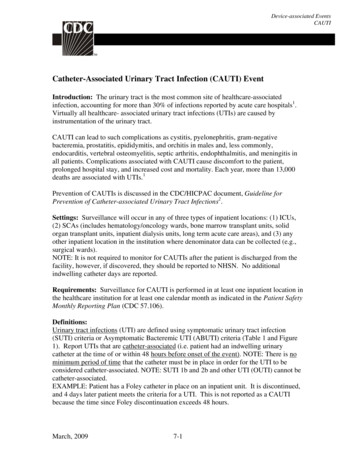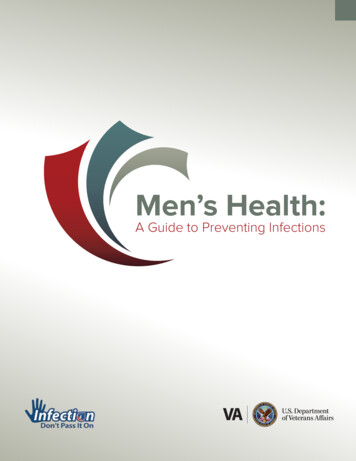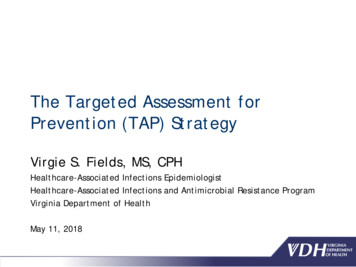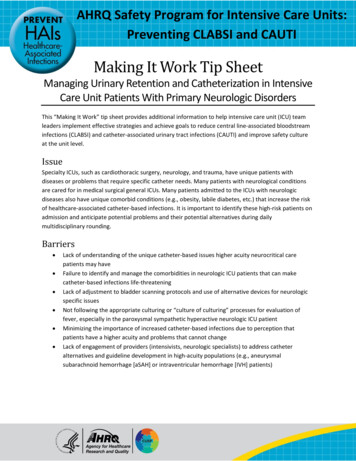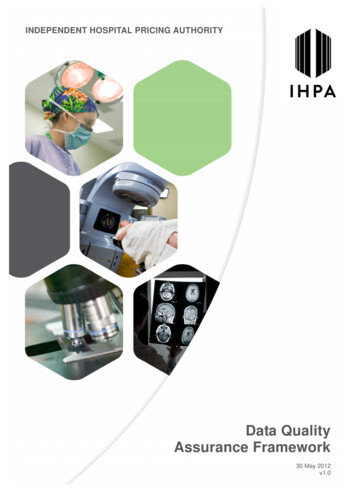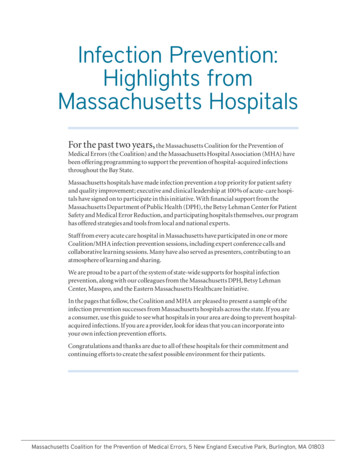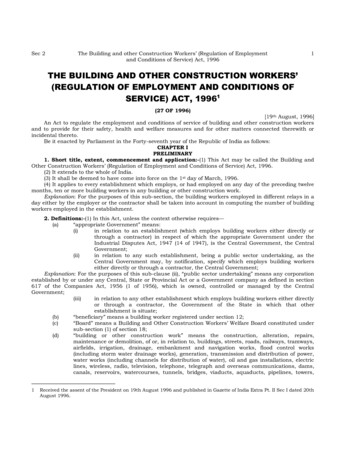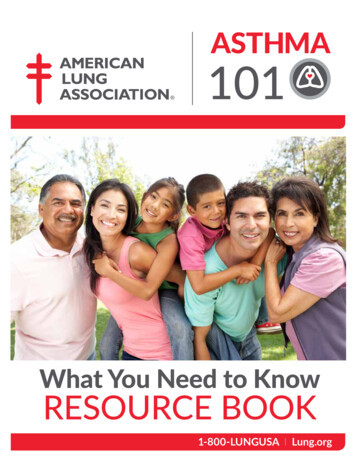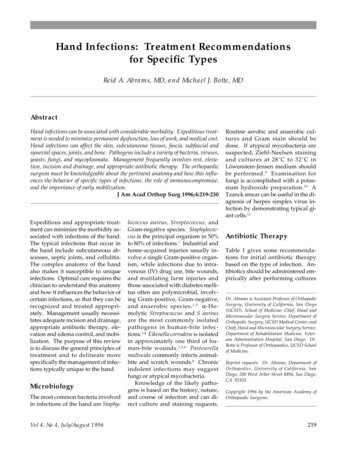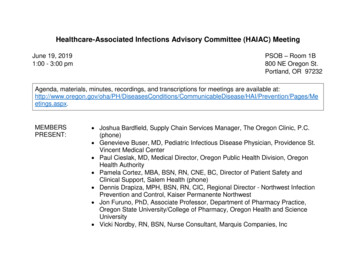
Transcription
Healthcare-Associated Infections Advisory Committee (HAIAC) MeetingJune 19, 20191:00 - 3:00 pmPSOB – Room 1B800 NE Oregon St.Portland, OR 97232Agenda, materials, minutes, recordings, and transcriptions for meetings are available .aspx.MEMBERSPRESENT: Joshua Bardfield, Supply Chain Services Manager, The Oregon Clinic, P.C.(phone) Genevieve Buser, MD, Pediatric Infectious Disease Physician, Providence St.Vincent Medical Center Paul Cieslak, MD, Medical Director, Oregon Public Health Division, OregonHealth Authority Pamela Cortez, MBA, BSN, RN, CNE, BC, Director of Patient Safety andClinical Support, Salem Health (phone) Dennis Drapiza, MPH, BSN, RN, CIC, Regional Director - Northwest InfectionPrevention and Control, Kaiser Permanente Northwest Jon Furuno, PhD, Associate Professor, Department of Pharmacy Practice,Oregon State University/College of Pharmacy, Oregon Health and ScienceUniversity Vicki Nordby, RN, BSN, Nurse Consultant, Marquis Companies, Inc
Kirsten Schutte, MD, Infectious Disease and Medical Director of InfectionPrevention and Control, Asante (phone)MEMBERSEXCUSED: Deborah Cateora, BSN, RN, Healthcare EDU/Training Coordinator and RNConsultant, Safety, Oversight and Quality Unit (SOQ Unit), Oregon Departmentof Human Services Kelli Coelho, RN, CASC, MBA, Executive Director, RiverBend AmbulatorySurgery Center Wendy L. Edwards, RN, BSN, Patient Safety Surveyor, Health FacilityLicensing and Certification, Oregon Public Health Division, Oregon HealthAuthority Jordan Ferris, BSN, RN, CMSRN, Nursing Practice Consultant, Oregon NursesAssociation Lisa Freeman, Executive Director, Connecticut Center for Patient Safety Laurie Polneau, RN, MHA, CPHRM, Director, Quality/RiskManagement/Infection Control, Vibra Specialty Hospital Portland Pat Preston, MS, Executive Director, Center for Geriatric Infection ControlOTHERPARTICIPANTSPRESENT: Jackson Baures, Public Health Division Manager, Jackson County (phone) Joyce Caramella, RN, CPHQ, CHC, Project Manager, HealthInsight Oregon Kari Coe, RN, BSN, IP Nurse, Communicable Disease Program, DeschutesCounty Health Services (phone) Sydney Edlund, MS, Director of Analytics and Research, Oregon Patient SafetyCommission (phone) Mesa Greenfield, BSN, RN, CWOCN, Infection Prevention/Employee HealthNurse, Lake District Hospital (phone)2
Ryan Grimm, Director of Surgical Services, Ambulatory Surgery Centers, ThePortland Clinic (phone) Stacey Karvoski, RN, BSN, Infection Control/Employee Health/OutpatientTherapy Manager, Wallowa Memorial Hospital (phone) Jesse Kennedy, RN, Nurse Practice Consultant, Oregon Nurses Association(phone) Karen Keuneke, RN, MSN, Supervisor of Infection Prevention, Good SamaritanRegional Medical Center (phone) Chitra Kanchagar, pharmacy student, OSU/OHSU Gretchen Koch, MSN, RN, Policy Analyst, Nursing Practice and Evaluation,Oregon State Board of Nursing (phone) Julie Koch, RN, MSN, BSN, CIC, Manager Infection Prevention, Salem HealthHospitals and Clinics L Dianne Long, Med/Surg Supervisor, St. Alphonsus Baker City (phone) Lauren Ogden, MPH, CIC, Infection Preventionist, Oregon Health and ScienceUniversity Mary Post, RN, MS, CNS, CIC, Infection Prevention/Employee HealthCoordinator, Shriners Hospitals for Children – Portland (phone) Kristine B. Rabii, MSc., Infection Preventionist, Tuality Healthcare (phone) Jessica Symank, RN, MPH, Senior Director, Patient Safety and QualityPartnerships, Washington State Hospital AssociationOHA STAFFPRESENT: Zintars Beldavs, MS, ACDP Section ManagerAlyssa McClean, AWARE CoordinatorValerie Ocampo, RN, MIPH, HAI Public Health NurseDiane Roy, HAI Data and Logistics CoordinatorMonika Samper, RN, Flu Vax Coordinator and Clinical Reviewer3
Lisa Takeuchi, MPH, HAI/AR Monitoring & Prevention Epidemiolgist Roza Tammer, MPH, CIC, HAI Reporting Epidemiologist Dat Tran, MD, HAI Outbreak Response Physician/Interim HAI & EIP ProgramManager Alexia Zhang, MPH, HAI EIP EpidemiologistISSUES HEARD: Call to order and roll callLogistics updateApprove March 2019 minutesOregon Health Authority (OHA) National Healthcare Safety Network (NHSN)reporting requirements2018 OHA NHSN reportingInjection practices and needle use in Jackson CountyDiscussion: topics for future meetings and reportsPublic commentAdjournThese minutes are in compliance with Legislative Rules. Only text enclosed in italicized quotationmarks reports a speaker’s exact words. For complete contents, please refer to the recordings.ItemCall to Order andRoll CallGenevieve Buser,Providence St.Vincent (Chair)Discussion8 members (53 percent) and 17 participants present.4Action ItemNo action items
Logistics UpdateRoza Tammer,Oregon HealthAuthorityHAIAC membership updates: Labor Representative position open; Jordan Ferris,Oregon Nursing Association, transitioning from role. Health Insurer Representative position still vacant.No action itemsApprove March2019 MinutesAll CommitteeMembersOHA NHSNReportingRequirementsMarch 2019 meeting minutes were approved by 53 percent ofmembers.No action items OHA mandates hospitals report HAI outcome measureslisted below to NHSN as specified in Oregon AdministrativeRules (OARs): Central line-associated bloodstream infections(CLABSIs) Catheter-associated urinary tract infections (CAUTIs) Laboratory-identified methicillin-resistantStaphylococcus aureus (MRSA) bloodstreaminfections (BSIs) Laboratory-identified Clostridium difficile infections(CDI) Surgical site infections (SSIs) resulting from followingprocedures:o Coronary artery bypass graft (CBGB)o Knee prosthesis (KPRO)o Colon surgery (COLO)o Hip prosthesis (HPRO)o Abdominal hysterectomy (HYST)o Laminectomy (LAM)Send questionsand commentsregardingreportingrequirements toRoza Tammer.Roza Tammer,Oregon HealthAuthority(See pages 19-28of meetingmaterials)5
Standardized infection ratios (SIRs) calculated using 2015baseline data reveal Oregon hospitals need to improve onfive metrics (SIR greater than one): CLABSIs in critical access hospitals (CAHs) MRSA BSIs in CAHs KPRO SSIs HPRO SSIs HYST SSIs National 2017 acute care hospital (ACH) SSI data showinfections are higher than predicted for a many adult and/orpediatric procedures including: craniotomy, cesareansection, open reduction of fracture, and kidney transplant. HAIAC members/participants proposed changes to currentreporting requirements. Hospitals:o Remove laminectomyo Add Non-Ventilator-Associated Pneumonia(PNEU)o Add Antibiotic Use/Antibiotic Resistance Add SSI reporting for ambulatory surgery centers:o Herniao Breasto Cholecystectomyo Cataract and other eye procedureso Joint procedures (e.g., hip, knee)o Laminectomy6
Question Paul Cieslak: What is the baseline for SIR?Roza Tammer: Baseline is 2015 national HAI data. SIR isobserved number of infections divided by predicted numberof infections. Predicted infections are estimated based onrisk-adjusted national baseline data for each HAI metric andfacility type.Question Roza Tammer: Comments on proposed changes tomandated reporting or additional ideas?Monika Samper: ASCs should report SSIs because of highvolume and increasing complexity of cases.Julie Koch: Laminectomies mostly performed in outpatientsetting. Risk is mainly when spinal fusion is done withlaminectomy so recommend only reporting fusions.Paul Cieslak: SIR is a relative rate so does not indicateabsolute rate. Less impressed by an SIR that increasedsince 2015 than a rise in absolute rate of an infection. Favoreliminating laminectomies without fusion. Believe infectionrates from breast and routine hernia surgeries are low.Should focus on surgeries with more infections and greatermobidity such as open reduction internal fixation of fracture(ORIF) regardless of whether inpatient or outpatient setting.Kristen Schutte: Agree, need to target procedures with highmorbidity and poor outcomes, including fusions in ASCs aswell as inpatient settings. Tracking ORIF would be7
interesting, but situations that put patients at risk arecomplicated. If ORIF used to treat open fracture, might bedifficult to determine amount of risk reducible through properantibiotic use or better infection prevention practices.Question Roza Tammer: Are proposed procedures high-volume andhigh-risk in ASCs?Dennis Drapiza: Our ASCs perform surgeries previouslydone in inpatient settings: laminectomy, breast, and herniaprocedures. Also, do high volume of cataract surgeries.ASCs recommended starting with reporting a few SSIsrather than all seven at once.Genevieve Buser: Perhaps begin with highest morbidity orfrequency like joint procedures previously done in inpatientlocations.Julie Koch: Some of our ASCs will be providing two-nightstays. Already considering moving inpatient joint proceduresto these ASCs. Joint procedures are my highest level ofconcern based on inpatient outcomes.Dennis Drapiza: Would be helpful to know type and numberof procedures being done in ASCs, how we’re doing, andways to improve outcomes.Question Genevieve Buser: Do hospital outpatient units currently fallunder NHSN inpatient reporting?8
Julie Koch: Outpatient units are not required to report data.Genevieve Buser: So ambulatory surgery center reportingwould not encompass outpatient hospital settings?Roza Tammer: Would only include procedures done inlicensed ASCs, regardless of duration of stay. Hospitals onlyrequired to report HAIs for inpatient procedures. Inpatientdefined as patient is admitted and discharged on differentcalendar days.Comment Roza Tammer: Reporting requirements could be expandedto include outpatient hospital procedures.Julie Koch: Need to restrict reporting to essential HAIsbecause IP resources limited.Ryan Grimm: To understand outpatient procedure infectionrates, need to look at hospital outpatient departments as wellas outpatient industry. However, staffing is a big issue soneed to effectively analyze and tailor reporting requirements.Proposed reporting not highly burdensome, but we’re biggerthan most independent ASCs. On board with reportingproposals, but not all procedures at once.Question Genevieve Buser: Any procedures you are concerned aboutdue to frequency or morbidity?Ryan Grimm: Infection rates low at our multi-specialtysurgery centers. Perform large number of cataract surgeries.9
Only remember one hernia and no breast procedureinfections. Ortho surgeries might have more infections butpossibly volume dependent.Paul Cieslak: Most interested in ASCs reporting jointprocedures due to incidence of infection.Question Dat Tran: Any significant differences in type and frequencyof procedures performed in ASCs versus hospital outpatientunits? Should know if we’re going to mandate reporting forboth facility types.Lauren Ogden: Would need to look at actual data.Question Julie Koch: What about antibiotic use?Lisa Takeuchi: 21 Oregon hospitals currently reportantibiotic use (AU); fewer report antibiotic resistance (AR).Nationwide only Missouri and Tennessee have mandatedselect hospitals report AU data. Tennessee first requiring AUdata from larger acute care hospitals, followed by smalleracute care hospitals, and eventually critical access hospitals.Challenge is purchase of expensive software ordevelopment of homegrown system to enable AU reporting.Lauren Ogden: We proposed AU reporting requirement tocommittee to help justify purchase of necessary software tohospital administration.10
Dennis Drapiza: Agree, would like AU module to support ourantimicrobial stewardship program.Roza Tammer: What about initially requiring hospitals withlarger bed size to report AU data and then periodicallyexpand mandate to smaller hospitals?Dennis Drapiza: Great idea.Kirsten Schutte: Agree with comments. However, need toimprove how we benchmark and use this information.Complicated in terms of defining when antibiotic should beprescribed and which drug is appropriate. How would databe employed to improve outcomes and quality of care?Question Dat Tran: Do facilities have opinion about AU versus ARreporting?Julie Koch: Would suggest AU because AR much morecomplicated. State could help facilities with benchmarking.Dat Tran: Oregon Antimicrobial Stewardship Network(ORASN) collaborative tasked with developing benchmarks.All facilities reporting AU will have a voice in determiningstandards.Paul Cieslak: Perhaps best to delay implementation of AUreporting until committee has determined how data will beused.11
Genevieve Buser: Recommend selecting well-defined area,such as sepsis, with nationally developed guidelines onappropriate antibiotic use.2018 OHA NHSNReportingLisa Takeuchi,Oregon HealthAuthority(See pages 29-45of meetingmaterials)Review of HAI Data CDC’s 2017 report compares Oregon data to national datafor acute care hospitals on six HAIs reportable to CMS.Report reveals: Oregon SIR significantly higher than national SIR forCAUTI. Difference between Oregon SIR and national SIRstatistically insignificant for:o CLABSIo HYST SSIo COLO SSIo MRSA BSIo CDI Oregon’s 2018 data show: Acute care and critical access hospitals – Oregon’sobserved infections compared to predicted infectionsfor all HAI categories either statistically insignificant orstatistically lower. Dialysis facilities – Oregon 2018 SIR significantly lowerthan national 2017 SIR for BSIs.Considerations for 2018 HAI Report Goal for annual report is to provide clear and conciseinformation that allows:12
Patients to make healthcare choices Healthcare facilities to improve patient safety Content of report: Online report published annually contains executivesummary, aggregate data, and facility-specific data. Formal report published about every three to five yearsincludes trend data. What topics should be included?o NHSN annual survey data such as facilitycharacteristics or antimicrobial stewardshipmetrics?o Recommendations for providers and patients onhow to minimize HAI risks like 2016 report?o Overview of how HAI Program uses data toinform and prioritize projects and activities?o Other topics?Responses:Dennis Drapiza: Recommendations are important, especiallysince report is meant for public.Zintars Beldavs: Can statistics be obtained on how public isusing online report? Information would help OHA improveoutreach.Jon Furuno: Important to know how report being utilized:some may view it to inform healthcare decisions while othersinterested in how data is used. However, utilization statisticswill not capture missing data/topics sought by users; whatinformation should be included is fairly intuitive. Also, need13
to consider whether a topic should be incorporated in reportor placed elsewhere on website.Genevieve Buser: Offering aggregate NHSN data fromannual survey (perhaps separate from report) would beuseful. Advantage of posting information online independentof report is that it can be updated in real time rather thanwhen report produced.Zintars Beldavs: Maybe include HAI Program activities andHAI prevention efforts of hospitals and collaboratives. Should OHA censor data of facilities who perform relativelyfew procedures? Concern about patient identification when numberssmall? Useful to present small numbers? Data not censored in previous OHA reports or Centerfor Medicare and Medicaid Services’ (CMS) HospitalCompare online reports.Responses:Julie Koch: Don’t think it’s an issue.Lauren Ogden: Problem if, for example, a hospital had 50central line days and reported 10 CLABSIs. When I scanneddata, did not find any issues.Lisa Takeuchi: Based on responses, will not censor data. How often should formal HAI report be produced?14
Responses:Jon Furuno: Frequency should be based on indications suchas marked changes in trend data, modifications to HAIdefinitions, new HAI categories, and addition of facility types.Lisa Takeuchi: So, will revisit question yearly. This year,OHA will generate formal report with trend data so readercan see how facilities doing. Provide printer-friendly PDF or web-based report? Latterwould permit tracking report usage.Responses:Julie Koch: We utilize both. Use web-based at my desk butgive chief officers paper copy in monthly public reportingmeetings.Lauren Ogden: Online is fine. Receive many calls frompublic asking for general information. Could place links toOHA recommendations on hospital website.Injection Practices OHA developed and implemented project to improve safetyand Needle Use inof injections and needle use in healthcare facilities usingJackson Countyfunds from CDC’s One and Only Campaign. Created survey to assess needle use and injectionRoza Tammer,practices to inform educational activities.Oregon Health Devised online toolkit for public and healthAuthorityprofessionals. Mailed or emailed surveys three times to Jackson Countylicensed providers, businesses, and facilities providinghealth-related services.15OHA askedattendees toreview Injectionand NeedleSafety Toolkit andprovide feedback.
(See pages 46-66of meetingmaterials) 9% response rate 272 surveys have sufficient data for analysis Analysis of surveys reveal diverse respondents, services,and practices. Providers and services:o Business/facility types encompassed: 47.8%inpatient, 50% outpatient, and 2.2%acupuncture.o Common provider types included: CNA, RN, NP,MD, and LAc.o Common needle-based or injection servicesincluded: biopsy, dialysis, blooddraw/phlebotomy, surgery, and acupuncture. Injection and needle-based practices:o Injectable medications/treatments administeredin 97% inpatient and 25% outpatient settings.o Medication vials “never” used on more than onepatient in majority of inpatient and outpatientlocations.o Safety syringes used by 76% inpatient and 46%outpatient facilities.o Needle-based treatment without injectionprovided in: 9% inpatient, 5% outpatient, and50% acupuncture settings. Medication practices:o Mix/reconstitute injectable medications less thanone hour before administration: 47% inpatient,34% outpatient, and 17% acupuncture.16
o Draw up injectable medications/treatments lessthan one hour before administration: 54%inpatient, 51% outpatient, and 17% acupuncture. Education:o Most inpatient and outpatient settings provideeducation on needle use/injection practices onceper year.o Majority of acupuncture clinics do not offerinstruction.o Inpatient respondents more interested ineducational topics listed in survey thanoutpatient respondents. Conclusions: Outpatient settings less likely to adhere to bestpractices. Facilities/businesses/providers need ongoingeducation. Next steps: Perform additional analyses and publish final report. Continue to review, update, and expand informationand resources in online toolkit. Continue to offer in-person and remoteeducation/training. Ask licensing boards to promote education to lendlegitimacy and impetus to efforts.17
Question Genevieve Buser: Will survey results be sent torespondents?Discussion:Topics for FutureMeetings andReportsAll attendeesPublic CommentAdjournRoza Tammer: Great idea. Kirsten Schutte:No action items Presentation on how to screen for measles; statewideguidelines would be helpful. Guidance from state on pandemics; unable togenerate alerts within health system when cases reachU.S. Julie Koch: Review Pandemic and All HazardsPreparedness Act (PAHPA) and discuss how facilitiesmanaging recommendations.No public commentNo action itemsNext meeting will be September 18, 2019, 1:00 pm - 3:00 pm, at Portland State Office Building,Room 1BSubmitted by: Diane RoyReviewed by: Roza Tammer18
Oregon State University/College of Pharmacy, Oregon Health and Science University Vicki Nordby, RN, BSN, Nurse Consultant, Marquis Companies, Inc . 2 . Jordan Ferris, BSN, RN, CMSRN, Nursing Practice Consultant, Oregon Nurses Association
